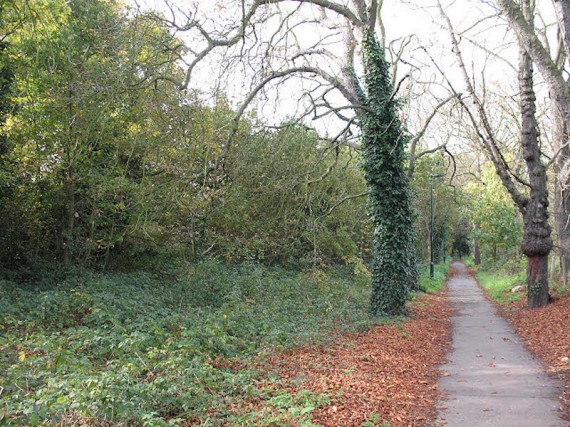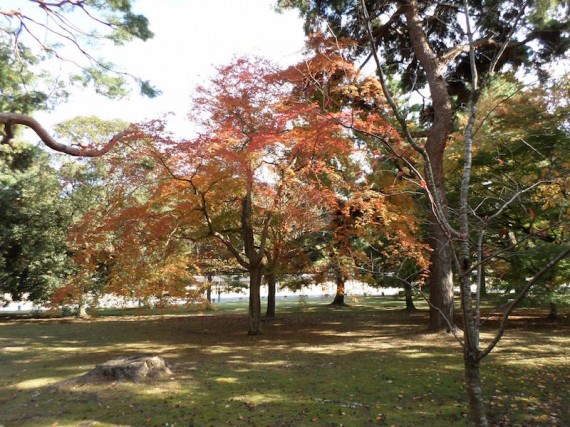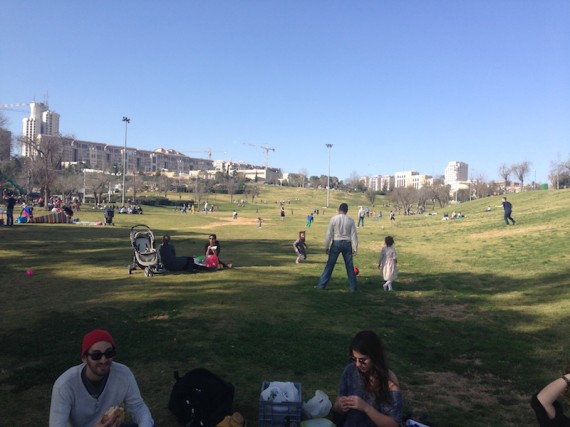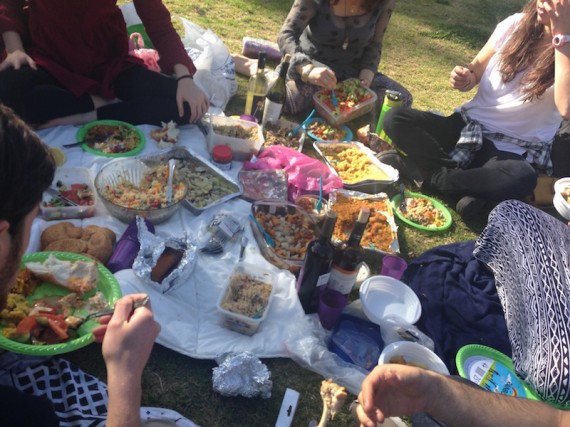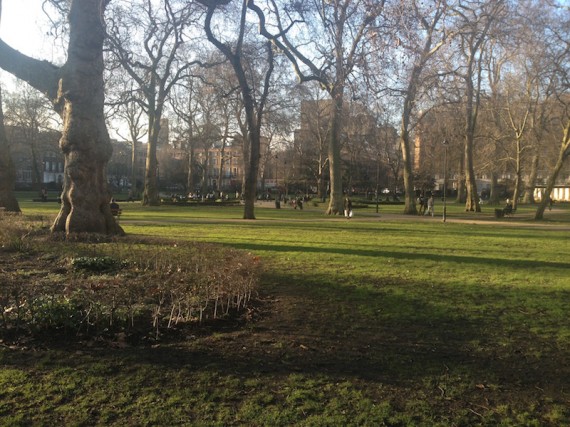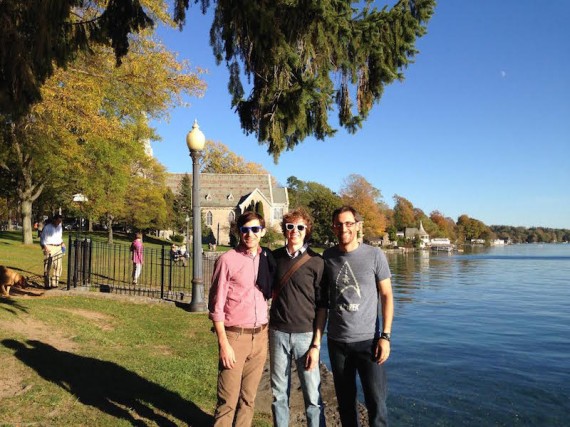Public Parks: Access to nature is often recognized as a key quality-of-life indicator, and for many people, public parks are the easiest place to find a bit of fresh air. But nature is not always as natural as it might seem. Indeed, the very term “landscaping” implies that something has been altered or reconfigured to fit an ideal — suggesting that, despite appearances, the “wildness” of New York’s Central Park is not so terribly different from the placid beauty of the Gardens at Versailles. This week, pay attention to parks. Is there an arboretum or other “natural” public place where you live? What is it called? Is it actively manicured or left wild? Who maintains it? What do people do there: Sports? Picnics? Protests? Theatre and music? Take a picture of the park and tell us how it’s commonly used.
Ryan Hildebrant ’17, Psychology & Japanese
The main Park in Kyoto serves all the functions one would expect: picnics, public events, sports, and general relaxation in nature. This park, which lies at a central location in the city of Kyoto, also happens to be the former Imperial palace and palace complex. One of my first experiences with the palace/park was a visit to the Palace, which is usually restricted. Having seen the inside, and this isn’t to belittle the beauty of the palace, it’s quite a nice residence, I have to say the outside of the palace and the palace grounds are much more spectacular.
The main palace is surrounded by walls and then an open expanse of gravel on all sides. Beyond that are various paths and miniature parks, with pine, maple, and many other trees overlooking the entirety of the grounds. During fall, the maple and other trees are famous for turning brilliant shades of crimson and bright yellow, and the result is a park cloaked in color for a few weeks or a month of the year.
Adam Basciano ’16, International Relations
Parks seem to be everywhere here in Jerusalem and Israel. On my daily walk to campus, I pass a large public garden/park that many students take advantage of for studying. On days that I am not running behind on schedule, I can walk through Hebrew University’s own Botanical Gardens which leads right to my day’s classes.
Since the weather has been magnificent ever since I have gotten year, each day you can see students relaxing from the stresses of their exam seasons by enjoying a smoke or a bite to eat. Jerusalem as a whole is also home to many large and beautiful public parks that get hundreds of visitors daily. Shabbat is the nation-wide day of rest, and as a result no businesses are open from sundown Friday until Saturday night. This means that on the weekends, Israeli families and visitors flock to public parks to enjoy picnics and time with family and friend. The two pictures shown are from last weekend when I enjoyed a pleasant day at the Gan Sacher park in the Nahalot village of Jerusalem with some Israeli and American friends.
Jerod Gibson-Faber ’16, History
The first thing I think I noticed about London is probably how the roads are all wrong here. After that though, I couldn’t help but be very impressed at all of the parks and open spaces throughout the city. I live in housing on 20 Bedford Place, very close to the British Museum. If you exited my flat, took a left, and kept walking straight, you would end up at Bloomsbury Square Gardens. I often times cut through here when I’m trying to get to Kingsway and go places.
It’s not the biggest park, but there is a small playground area that I would love to play in if I were about 17 years younger. People also walk their dogs around and on the green, which the dogs seem to love – they are all so friendly. Go back to my flat, take a right instead, keep walking straight, and you’d end up at Russell Square. This space is a bit larger and in addition to dogs and readers on park benches, runners frequent the park on their daily routes. I’m pretty spoiled with a park on each end of the street I live on, but it seems like little green open spaces like these are not hard to find – especially in central London. There are a number of larger parks, too, like Regents, Hyde, and St. James’s to name but a few. As far as the authenticity of the natural environment, it’s tough to say. These places – especially Greenwich – were heavily attacked in WWII. Some parks were even dug into for shelters from bombing. It’s a pretty safe bet that however the land recovered after the war, it’d still in that condition – with maintenance of course.
Katrina Bennett ’16 Neuroscience
Cape Town is an amazingly beautiful place. One of the best places to take advantage of the natural beauty that this city has to offer is Kirstenbosch Botanical Gardens. This absolutely beautiful area of land is full of amazing flowers, green grass and the start of many treacherous and steep hiking trails up gorgeous mountains. These gardens are a wonderful place to have a picnic or just enjoy a beautiful day, but also are home to many amazing events. My favorite to attend have been the Kirstenbosch Summer Concert series where modern and popular South African bands perform on a beautiful outdoor venue backed by the picturesque mountains and the sky line of the city of Cape Town. Besides these concerts, Kirstenbosch holds outdoor movie screenings on a large screen every week, monthly food and craft fairs, and has a wonderful tea room and art gallery. Kirstenbosch Gardens are without a doubt one of my favorite places in Cape Town and I have spent some of my favorite evenings and afternoons there.
Katrina Bennett ’16 Neuroscience
Cape Town is an amazingly beautiful place. One of the best places to take advantage of the natural beauty that this city has to offer is Kirstenbosch Botanical Gardens. This absolutely beautiful area of land is full of amazing flowers, green grass and the start of many treacherous and steep hiking trails up gorgeous mountains. These gardens are a wonderful place to have a picnic or just enjoy a beautiful day, but also are home to many amazing events. My favorite to attend have been the Kirstenbosch Summer Concert series where modern and popular South African bands perform on a beautiful outdoor venue backed by the picturesque mountains and the sky line of the city of Cape Town. Besides these concerts, Kirstenbosch holds outdoor movie screenings on a large screen every week, monthly food and craft fairs, and has a wonderful tea room and art gallery. Kirstenbosch Gardens are without a doubt one of my favorite places in Cape Town and I have spent some of my favorite evenings and afternoons there.
Peter Tschirhart, Assistant Dean for Undergraduate Scholars Programs


